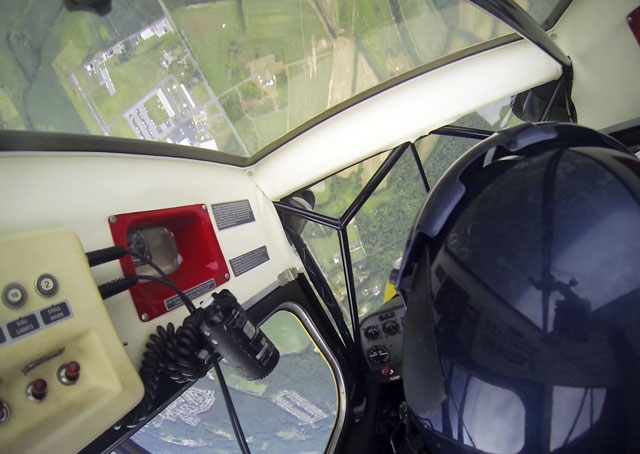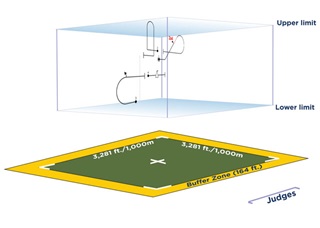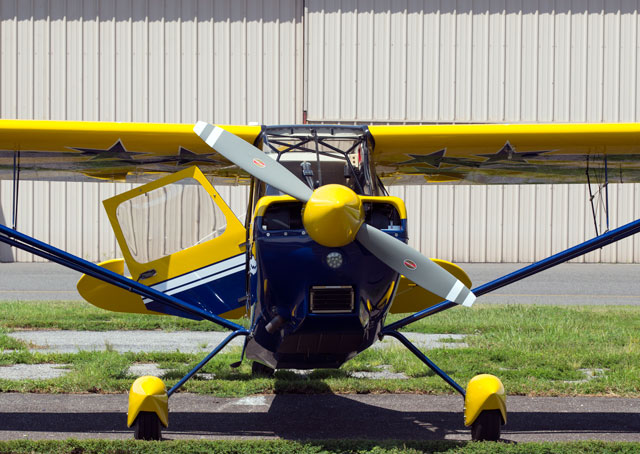
A heaping helping of humble pie awaited my return to South Jersey Regional Airport on Aug. 7. The day began at sunrise with 3.5 hours of driving to the Kathy Jaffe Challenge, the annual contest held by Chapter 52 of the International Aerobatic Club in Lumberton, New Jersey. Not driving down the night before was arguably my first mistake, followed within a couple of hours by another, more important error.
“I hate to be the bearer of bad news,” said Rob Dumovic, the instructor from Executive Flyers Aviation, whose (unfamiliar to me) Super Decathlon I was renting for this contest. He’s about the nicest guy you’d ever want to meet. “But it looked to me like you flew everything after the hammer in the wrong direction.”
Unfortunately for me, it looked that way to the judges, also, and my score sheet contained four sets of “hard zeroes,” awarded for flying the respective figures in the wrong direction, and a grand total of 44 percent of my potential points. It was, in those terms, a new low: That one wrong turn cost enough points to all but guarantee a last-place finish, even with two flights still to go. Make that a double slice of humble pie. To their credit, and to a person, my fellow pilots did their best to offer consolation or help me find the humor in it. It happens to everybody, many said.
“Those figures looked pretty nice,” said Marc Nathanson, among those who had witnessed my aerial debacle.
“Yeah, but they were in the wrong direction.”
“But they looked nice.”
We both laughed.
The International Aerobatic Club sanctions organized competitions across the country, and makes very clear in the rule book that there is a correct way to fly each figure (maneuver), down to the details of heading, angles of lines, roundness of loops, timing, and many other criteria; the rule book also specifies that figures flown from the judges’ right to left (or vice versa) must be flown in a specified direction (figures oriented on the Y axis can be flown toward or away from the judges, at the pilot’s discretion, though the X axis must be rejoined in the correct direction). It is therefore pretty important to remember to turn back onto the X axis correctly. I knew that going in, of course, but funny things can happen between the ears in the midst of a sequence, and relying on visual cues from the ground is not always the best plan—even when the nose is pointed straight down and the view of the ground is pretty darn good. There is little time to ponder it.

All of the figures in a sequence must also fit within a 3-D space that measures one kilometer (3,281 feet) on the X and Y axes (which are parallel to the ground), and also has vertical limits. Just over 18 nautical miles east of Philadelphia International Airport, this particular contest box has a very hard upper limit of 3,500 feet. (The FAA is quite insistent on this point, and controllers will call the contest director and potentially shut the contest down if one of our blips strays above that line. Not getting smacked by an airliner is another excellent reason to respect the altitude limit.) The lower limit is 1,500 feet agl for Primary and Sportsman pilots, the latter of which was my category; Intermediate, Advanced, and Unlimited pilots get a little more space to work with, though it’s still not a lot of space at airplane speeds. Though 1,500 feet is a nice cushion for safety, it's not one to be trifled with.
Fly enough contests, I was told more than once, and you’re guaranteed to get yourself a lousy score. Randol Webb, a retired airline pilot who flew his Piper J3C-65 with all of 75 horsepower (which requires a pretty high degree of skill), had the best line I heard all weekend: My flights are all wonderful. It’s just that the judges don’t always see that. (I paraphrase.)
Webb has been flying contests long enough to know that the ability to not take oneself too seriously is just as essential to a competitor as airmanship and focus. Those who get too worked up about a low score generally don’t come back for more, which is a pity, because even those of us who remain unaccustomed to scoring high learn much from each attempt. Lessons include advanced aerodynamics, making unusual attitudes pretty usual, overall proficiency, and, yes, confidence. Even on a tough day. Heck, three of my four landings all weekend were among my best tailwheel touchdowns yet, as I could not help brag about to anyone who would listen, usually drawing a tolerant smile, sometimes a laugh. More than one fellow pilot noted that judges don’t grade our landings. (Which is often a good thing, from my perspective.)
Thanks go to my friends at IAC 52 for putting another good contest together, and particularly to the pilots who helped take the edge off a bad day. Saturday was better, with a whopping 71.6 percent scored on my second of three flights—about the same as I managed to average at the Green Mountain Aerobatic Contest two weeks prior. Congratulations to Dumovic, who won Sportsman in the same airplane I flew. I’ll have to cross the airplane off the list of potential excuses, though. Nice going, Rob.
I now have five more weekends to practice, weather permitting, for the U.S. National Aerobatic Championships, so it is time to wash down the humble pie with a nice sports drink and get back at it. I’ll have more to tell you in the weeks to come, including introductions to some of the characters that make this sport the entertaining challenge that it is—even when you roll the wrong way.




